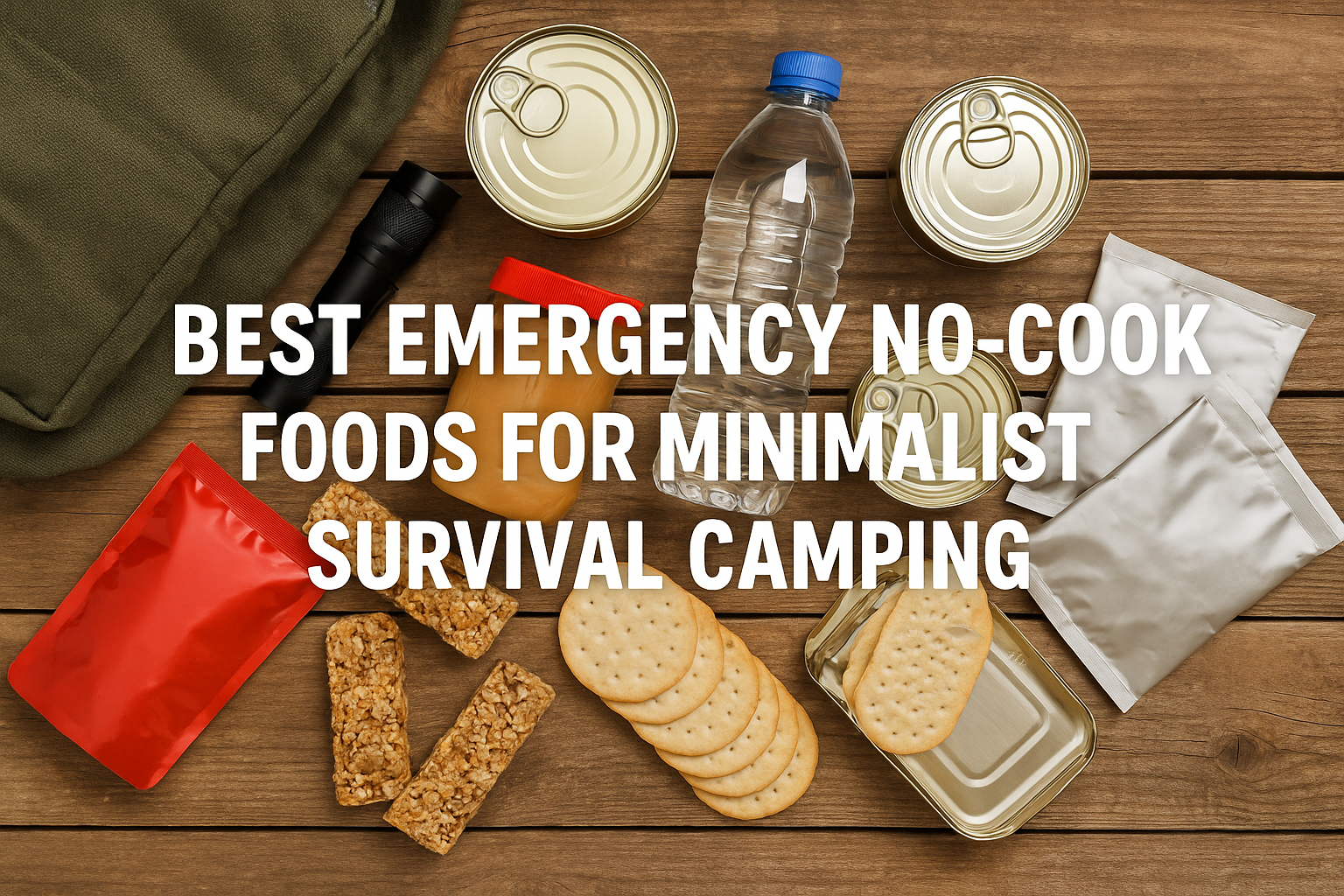When you’re deep in the wilderness, and your stove breaks,
your fire won’t start,
or you’re too cold and tired to think —
what you eat next could decide whether you make it back alive.
Most “no-cook camping food” lists assume you’re sipping coffee at a picnic table.
Real minimalist survival food must survive storms, cold, wet packs, weeks without refrigeration, and be edible with no heat.
Here’s the non-obvious, field-tested list of the best no-cook survival foods you must pack for minimalist survival camping.
🛡 What Survival Food MUST Do (Not Just Taste Good)
✅ Be high in fats, sugars, and proteins (the real survival macronutrients)
✅ Be ready to eat without heat, complicated prep, or tools
✅ Be shelf-stable for weeks or longer in all weather
✅ Be compact and heavy on calories, not empty air
✅ Cause minimal digestive distress under survival stress (avoid fiber bombs)
🥜 1. Nut Butters in Hard Packs (High-Calorie Core Survival Fuel)
Why it’s survival-grade:
- 180–220 calories per 2 tablespoons
- Massive fat energy for cold survival
- Never needs cooking
- Can be eaten straight or added to anything else
Best Types:
- Peanut butter (most affordable)
- Almond butter (high magnesium)
- Coconut butter (fast-burning fats)
Field Hack:
Choose foil squeeze packs over glass jars — lighter, unbreakable, easier to portion in a survival panic.
Bonus:
Smeared inside tortillas = instant emergency energy wraps.
🍖 2. Oil-Packed Tuna or Salmon Pouches (Not Water-Packed!)
Why it’s essential:
- Protein + survival fats combined
- Oil-packing gives extra calories compared to dry pouches
- Fully shelf-stable for months
Pro Tip:
- Tuna in olive oil has 50% more calories than “in water” versions.
- Always carry a few mustard or mayo packets to mix if available — instant survival mash.
Emergency Tip:
Can drink leftover oil in extreme starvation for pure fat calories.
🍫 3. High-Fat, Low-Melt Chocolate (Not Candy Bars)
Survival chocolate must:
- Be 70% cacao or higher (low-sugar, high-fat)
- Resist melting at moderate heat (over 80°F)
Why it works:
- Immediate glucose spike for energy
- Caffeine-like mild stimulant
- Sustaining cocoa butter fat for longer burn
Field Trick:
- Break into small pieces for slow nibbling across hours — prevents blood sugar crash cycles.
In survival, chocolate is medicine disguised as morale.
🥖 4. Pilot Bread (Survival Hardtack) + Honey Packets
Why it’s not obvious but critical:
- Pilot bread (military hard bread) lasts years without spoilage
- Honey never spoils — and provides 100% sugar fuel instantly
- Together = portable glucose + filler meal
Field Tip:
- Spread honey thinly on pilot bread → chew slowly → sip water alongside for digestion.
- Honey also acts as emergency wound dressing if injured.
You’re not eating for luxury — you’re eating for glucose and slow-burn carbs.
🥩 5. High-Fat Jerky (Not Lean “Diet” Jerky)
Most people pack dry, lean jerky — big mistake in survival.
You want:
- Pork jerky
- Fat-marbled beef jerky
- Salmon jerky
Why:
- Lean jerky dries you out and provides no long-burn fuel.
- Fatty jerky hydrates better and keeps energy stable longer.
Survival Hack:
- Always eat jerky slowly, chewing thoroughly.
- Wash down with small sips of water to avoid gut shock.
🥥 6. Dehydrated Coconut Chips or Dried Banana Chips
Best no-cook plant survival foods:
- Coconut chips (pure fat + fiber)
- Dried banana chips (potassium + sugar)
Why they’re powerful:
- Lightweight and immune to spoilage
- Provide essential electrolytes often ignored in survival situations (potassium, magnesium)
Pro Tip:
Mix coconut chips into peanut butter for super-dense emergency meals.
🥣 7. Cold-Soak-Ready Instant Oats (Survival Porridge)
Why oats beat granola bars:
- Oats can cold-soak with just purified water
- No sugar crashes like candy bars
- Slow-release carbs for long endurance
Field Method:
- Pre-mix oats with powdered milk and dried fruit into ziplock bags
- Add cold water at camp, seal, let soak 30–45 minutes.
Emergency Boost:
- Add nut butter or crushed chocolate pieces after soaking.
🧂 8. Salt Packets and Electrolyte Mix (Life Support)
Most survival food lists forget salt.
Without salt, you die faster.
Pack:
- Pure salt packets
- Small tube of electrolyte drink powder (like DripDrop, Liquid IV, or LMNT)
Why:
- Salt maintains water retention (prevents dehydration)
- Electrolytes stabilize nerve and muscle function under cold and exhaustion
Critical Hack:
- Sip diluted electrolyte water across the day — don’t chug or you risk diarrhea.
🥜 9. Emergency Nut-Seed Bombs (Pocket Survival Meals)
DIY Survival Bomb:
- Almonds
- Walnuts
- Pumpkin seeds
- Sunflower seeds
- Crushed dried coconut
- Honey binder
Mix into dense clusters inside small bags or wax paper.
Why it’s elite survival food:
- High-fat, protein, and minerals
- Chew small pieces through the day for slow energy drip
Bonus:
Carry 2–3 bombs in jacket pockets — reachable without unpacking bag during emergency movement.
📦 How to Pack No-Cook Survival Foods Smartly
✅ Use small ziplocks and squeeze packs for minimal space.
✅ Pre-portion cold soak meals separately.
✅ Vacuum-seal high-fat items if possible to extend shelf life.
✅ Distribute food across your gear (not just one bag) to avoid losing all meals in one accident.
🛡 Final Emergency Meal Strategy (When You Can’t Cook)
| Need | Survival Food |
|---|---|
| Immediate glucose | Honey, chocolate, dried fruit |
| Endurance calories | Nut butters, jerky, coconut chips |
| Electrolyte balance | Salt, electrolyte powder |
| Cold-soak meals | Instant oats, pilot bread |
| Mental morale | Chocolate, honey bombs |
🌄 Conclusion: Without Fire, Your Pack Becomes Your Pantry
When fire is gone, stoves fail, or cold hands won’t strike a spark —
your survival doesn’t depend on cooking.
It depends on what you packed.
Minimalist survival food isn’t about cravings — it’s about calories, electrolytes, and strategic gut fueling.
Choose dense.
Choose fast.
Choose smart.
And you won’t just camp —
you’ll outlast the cold, the storm, and the night.

